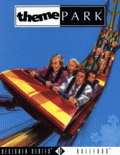
































Theme Park

Theme Park is a construction and management simulation video game developed by Bullfrog Productions and published by Electronic Arts in 1994. The player designs and operates an amusement park, with the goal of making money and creating theme parks worldwide. The game is the first instalment in Bullfrog's Theme series and their Designer Series.
Development took about a year and a half, with the team aiming for as much realism as possible. Certain features, including multiplayer, were dropped. Over 15 million copies were sold, and ports for various games consoles were released, most in 1995. Theme Park received generally positive reviews. Reviewers praised the gameplay and humour, but criticised console ports for reasons such as lack of save or mouse support. The game received a Japanese localisation (in addition to normal Japanese releases), Shin Theme Park, released in 1997 for the Sega Saturn and Sony PlayStation, and remakes for the Nintendo DS and iOS, released in 2007 and 2011 respectively. Theme Hospital is Bullfrog's thematic successor to the game, and two direct sequels followed: Theme Park World (known as Sim Theme Park in some territories) and Theme Park Inc (also known as SimCoaster).
Starting with a free plot of land in the United Kingdom and few hundred thousand pounds, the player must build a profitable amusement park. Money is spent on building rides, shops, and staff, and earned through sale of entry tickets, merchandise, and refreshments. Shops available include those selling foodstuff (such as ice creams) or soft drinks, and games such as coconut shies and arcades. Their attributes can be customised, which may affect customers' behaviour: for example, affecting the flavour of foods (e.g. by altering the amount of sugar an ice cream contains) may affect customers' enticements to return. Facilities such as toilets, and items that enhance the park's scenery (such as trees and fountains) can be purchased. Over thirty attractions, ranging in complexity from the bouncy castle and tree house to more complicated and expensive rides such as the roller coaster and Ferris wheel are available. Also available as rides are shows (called 'acts') with themes such as clowns and mediaeval. Certain rides, such as roller coasters, require a track to be laid out. The ride complement varies between platforms: for example, the PlayStation version is missing the mediaeval and dolphin shows. Rides require regular maintenance: if neglected for too long they will explode. Depending on the platform, it is possible to tour the park or the rides.
Visitors arrive and leave via a bus. The entry price can be set, and loans can be taken out. The player starts with a limited number of shops, rides, and facilities available. Research must be carried out to purchase others. Research can also make rides more durable, staff more efficient, and buses larger with increased capacity. The topic of research and how much funding goes into it is determined by the player.
Staff available for employment include entertainers, security guards, mechanics, and handymen. Lack of staff can cause problems, including messy footpaths, rides breaking down, crime, and unhappy visitors. If visitors become unhappy, thugs may come to vandalise the park by committing offences such as popping balloons, stealing food, and beating up entertainers. Occasionally, wages and the price of goods must be negotiated; failure to reach an agreement results in staff strikes or loss of shipment.
Theme Park offers three levels of simulation: the higher difficulties requiring more management of aspects such as logistics. For example, at full level, the player must manage research, negotiations, stocks, and shares. On sandbox, the game does not involve those aspects. The player can switch mode at any time. Game time is implemented like a calendar: at the end of each year, the player is judged on that year's performance against rivals. Game speed can be adjusted, and staff can be moved by the player. Cash awards may be earned for doing well, and trophies may be awarded for achievements such as having the longest roller coaster.
The goal is to increase the park's value and available money so that it can be sold and a new lot purchased from another part of the world to start a new theme park. Once enough money has been made, the player can auction the park and move on to newer plots, located worldwide and having different factors affecting gameplay, including the economy, weather, terrain and land value. The Mega Drive and SNES versions feature different settings (e.g. desert and glacier) depending on the park's location.
How to play:
Click on the joystick icon in the Theme Park online emulator to see how to control the Theme Park game









































Comments